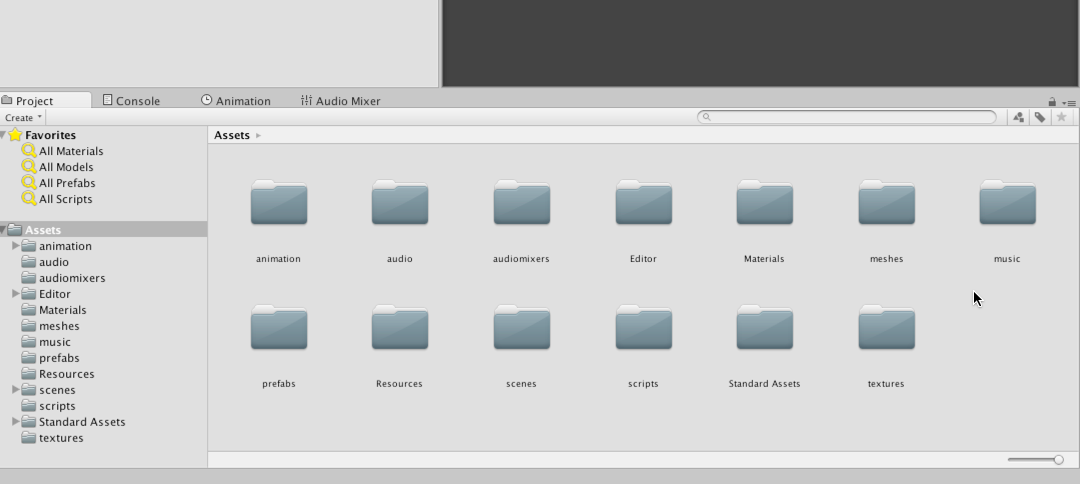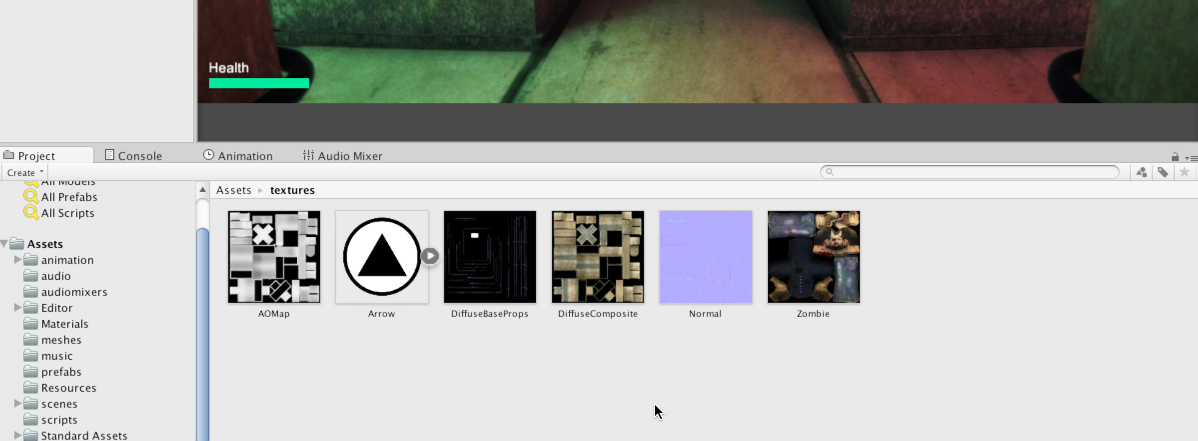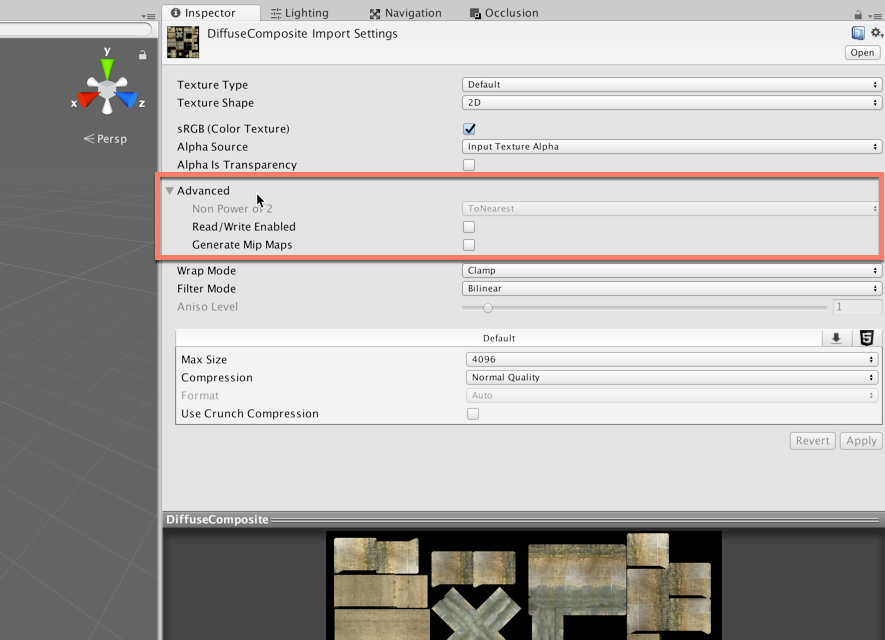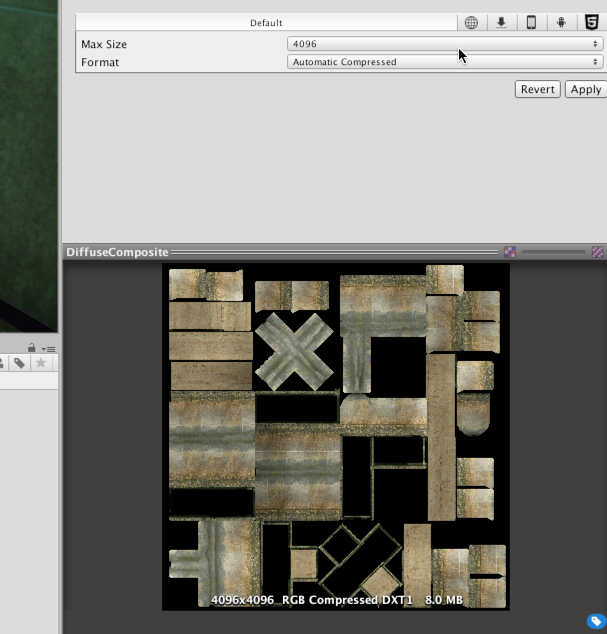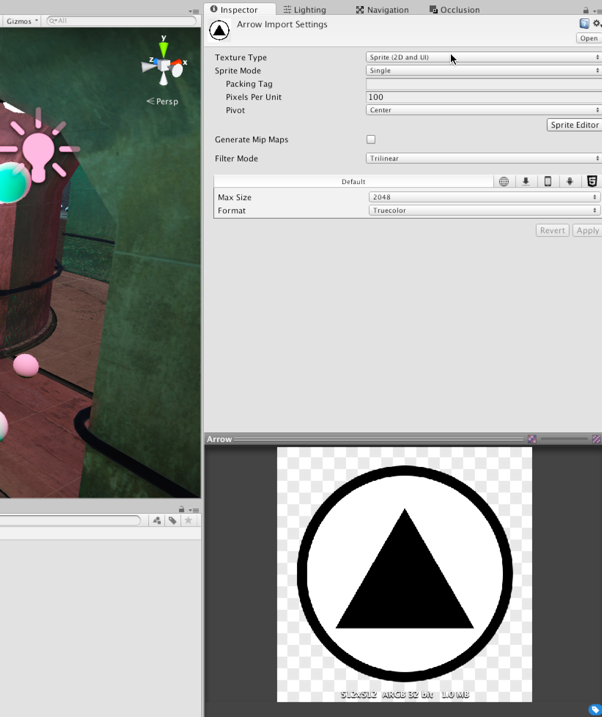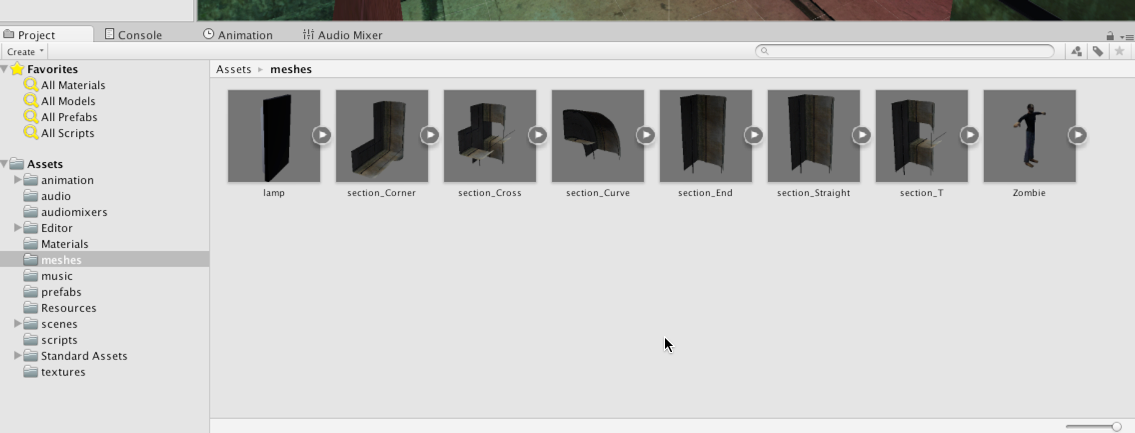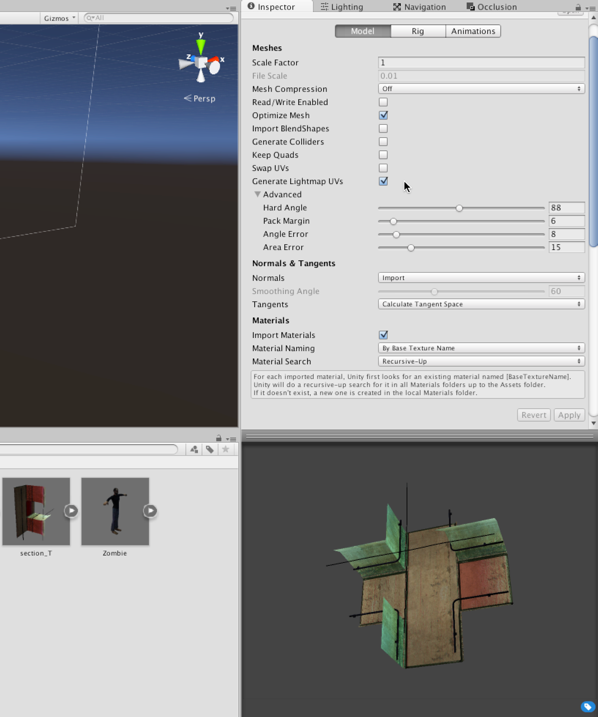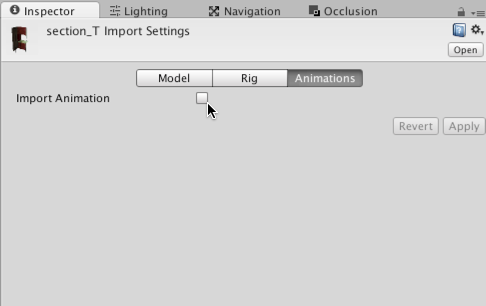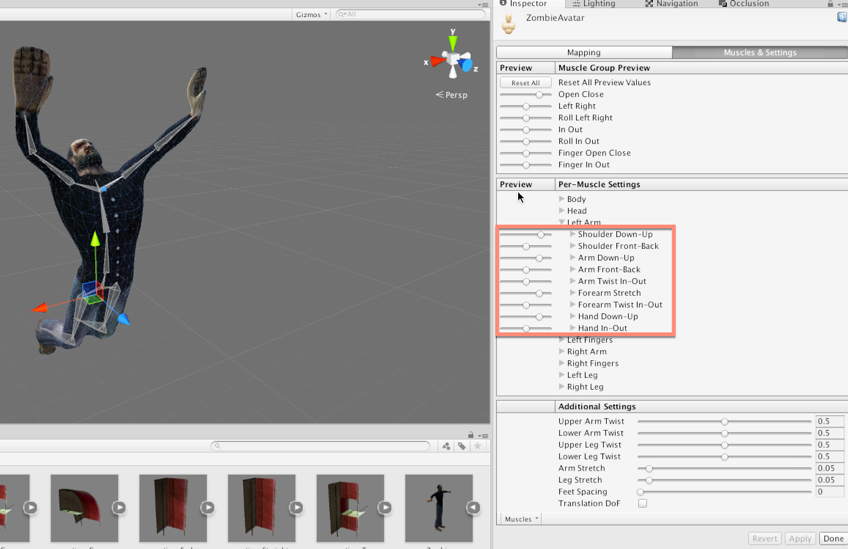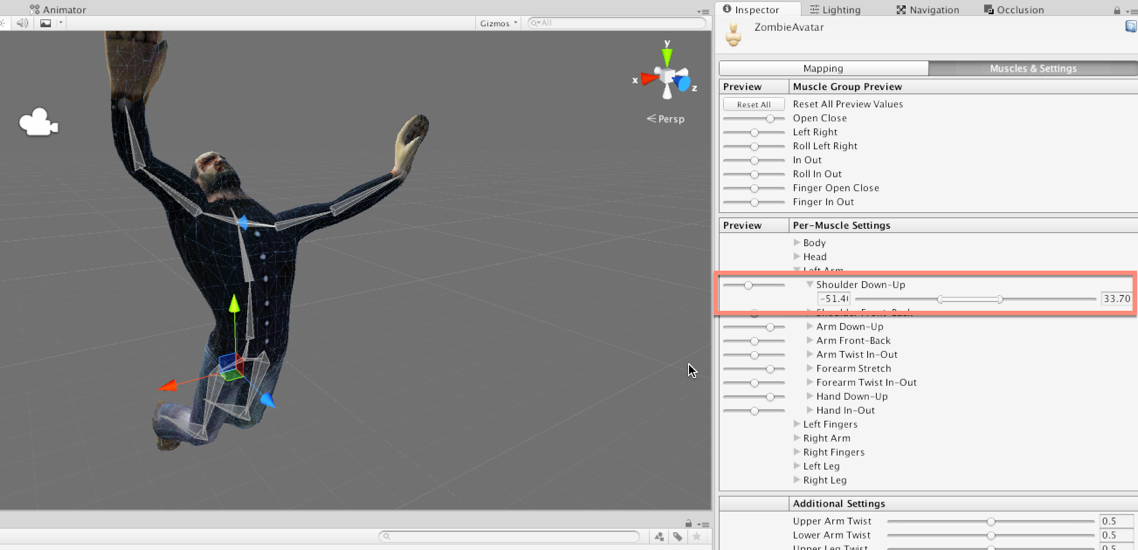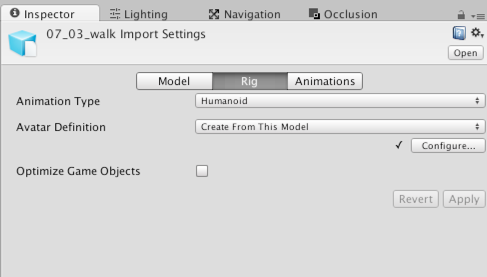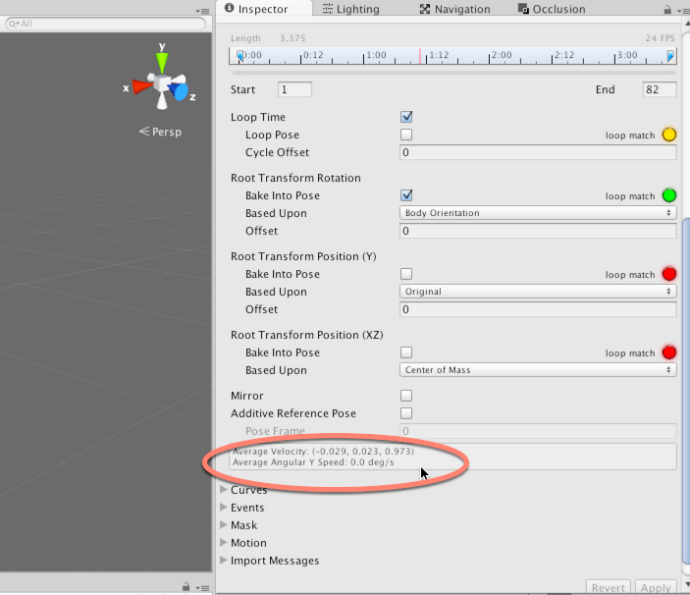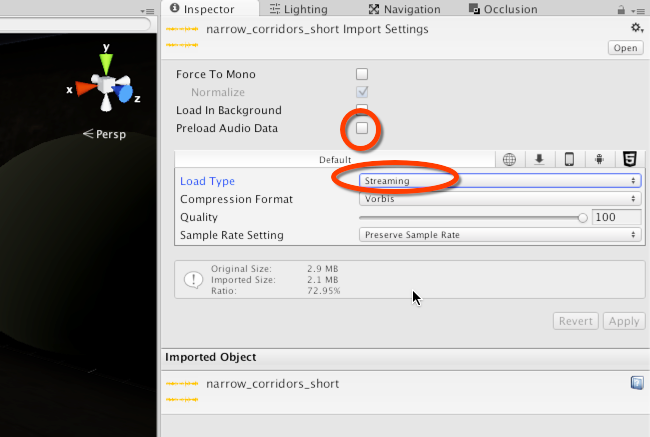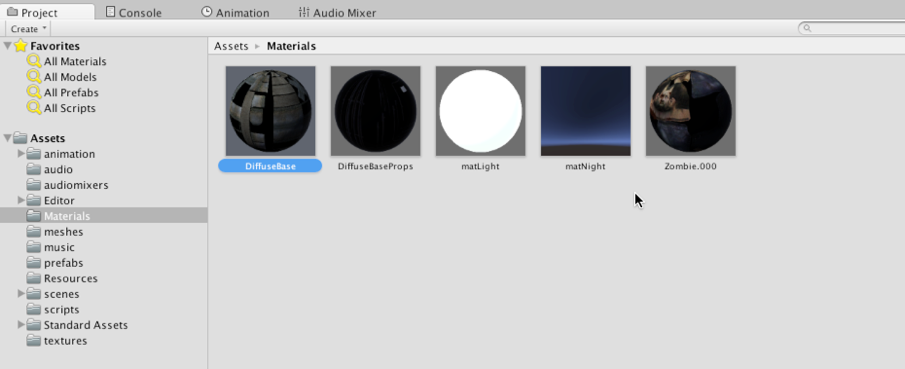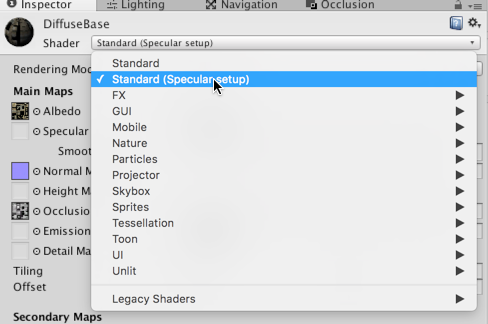Ideally, you should import textures before meshes, as we've done here. This is because, on mesh import, Unity automatically creates materials and searches the project for all associated textures. On finding suitable textures, it assigns them to the materials before displaying the results on the mesh, even in the Project panel thumbnail previews. This makes for a smoother and easier experience. When you're ready to import meshes, just drag and drop them into the Project panel to the designated meshes folder. By doing this, Unity imports all meshes as a single batch. This project relies heavily on meshes--both animated character meshes for the NPC zombies and static environment meshes for the modular environment--as well as prop meshes and any meshes that you would want to include for your own creative flourish. These files (except your own meshes) are included in the book's companion files:
Importing meshes (both environment and character meshes)
Now, let's configure the modular environment meshes. Select all meshes for the environment, including section_Corner, section_Cross, section_Curve, section_End, section_Straight, and section_T. With the environment meshes selected, adjust the following settings:
- Set the mesh Scale Factor to 1, creating a 1:1 ratio between the model, as it was made in the modeling software, to how the model appears in Unity.
- Disable Import BlendShapes; the environment meshes contain no blended shapes to import, and you can streamline to the import and re-import process by disabling the unnecessary options.
- Disable Generate Colliders; in many cases, we'd have enabled this setting. However, Dead Keys is a first-person shooter with a fixed AI-controlled camera, as opposed to free roam movement. This leaves the player with no possibility of walking through walls or passing through floors.
- Enable Generate Lightmap UVs, which generates a second UV channel. Unity automatically unwraps your meshes and guarantees no UV island overlap. You can further tweak light map UV generation using the Hard Angle, Pack Margin, Angle Error, and Area Error settings. However, the default settings work well for most purposes. The Pack Margin can, and perhaps should, be increased if your light map resolution is low, as we'll see in the next chapter. The angle and error settings should sometimes be increased or decreased to better accommodate light maps for organic and curved surfaces:
Configuring environment meshes
In addition to configuring the primary mesh properties, as we've seen, let's also switch to the Rig and Animations tab. From the Rig tab, specify None for the Animation Type field, as the meshes don't contain animation data:
Setting the Rig type for environment meshes
Next, switch to the Animations tab. From here, remove the check mark from Import Animation. The environment meshes have no animations to import; then, click on Apply:
Disabling Import Animation
Of course, Dead Keys is about completing typing exercises to destroy zombies. The zombie character for our project is based on the public domain zombie character, available from Blend Swap at: http://www.blendswap.com/blends/view/76443. This character has been rigged and configured in Blender for easy import to Unity. Let's configure this character now. Select the Zombie mesh in the Project panel and from the object Inspector, adjust the following settings:
- Set the mesh Scale Factor to 1 to retain its original size.
- Enable Import BlendShapes to allow custom vertex animation.
- Disable Generate Colliders, as collision detection is not needed.
- Enable Swap UVs if the texture doesn't look correct on the zombie model from the preview panel. If an object has two or more UV channels (and they sometimes do), Unity occasionally selects the wrong channel by default:
Configuring a zombie NPC
Switch to the Animations tab and disable the Import Animation checkbox. The character mesh should, and will, be animated--performing actions such as walking and attacking animations. However, the character mesh file itself contains no animation data. All character animations will be applied to the mesh from other files:
Disable Import Animation for the zombie NPC
That's great! Now, let's configure the character rig for Mecanim. This is about optimizing the underlying skeleton to allow the model to be animated. To do this, select the Rig tab from the Inspector object. For the Animation Type, choose Humanoid; and for Avatar Definition, choose Create From This Model. The Humanoid animation type instructs Unity to see the mesh as a standard bipedal human--a character with a head, torso, two arms, and two legs. This generic structure (as defined in the avatar) is mapped to the mesh bones and allows Animation Retargeting. Animation Retargeting is the ability to use and reuse character animations from other files and other models on any humanoid:
Configuring the zombie rig
After clicking on the Apply button for the zombie character, a check mark icon appears next to the Configure... button. For some character meshes, an X icon may appear instead. A check mark signifies that Unity has scanned through all bones in the mesh and successfully identified a humanoid rig, which can be mapped easily to the avatar. An X icon signifies a problem, which can be either minor or major. A minor case is where a humanoid character rig is imported, but differs in subtle and important ways from what Unity expects. This scenario is often fixed manually in Unity, using the Rig Configuration Window (available by clicking on Configure...). In contrast, the problem can be major; for example, the imported mesh may not be humanoid at all, or else it differs so dramatically from anything expected that a radical change and overhaul must be made to the character from within the content creation software:
Character rig successfully configured
Even when your character rig is imported successfully, you should test it inside the Rig Configuration Editor. This acts as a sanity check and confirms that your rig is working as intended. To do this, click on the Configure... button from the Rig tab in the object Inspector; this displays the Rig Configuration Editor:
Using the Rig Configuration Editor to examine, test, and repair a skeleton avatar mapping
From the Rig Configuration Editor, you can see how imported bones map to the humanoid avatar definition. Bones highlighted in green are already mapped to the Avatar, as shown in the Inspector object, that is, imported bones turn green when Unity, after analysis, finds a match for them in the Avatar. The Avatar is simply a map or chart defined by Unity, namely, a collection of predetermined bones. The aim of the Rig Configuration Editor is to simply map the bones from the mesh to the avatar, allowing the mesh to be animated by any kind of humanoid animation.
For the zombie character, all bones will be successfully automapped to the avatar. You can change this mapping, however, by simply dragging and dropping specific bones from the Hierarchy panel to the bone slots in the Inspector object:
Defining avatar mappings
Now, let's stress test our character mesh, checking its bone and avatar mapping and ensuring that the character deforms as intended. To do this, switch to the Muscles & Settings tab from the Inspector object. When you do this, the character's pose changes immediately inside the viewport, which means it is ready for testing:
Testing bone mappings
From here, use the character pose sliders in the Inspector object to push the character into extreme poses, previewing its posture in the viewport. The idea is to preview how the character deforms and responds to extremes. The reason such testing is necessary at all is that although bipedal humanoids share a common skeletal structure; they differ widely in body types and heights--some being short and small, and some being large and tall:
Testing extreme poses
If you feel your character breaks, intersects, or distorts in extreme poses, you can configure the mesh deformation limits, specifying a minimum and maximum range. To do this, first expand the Per-Muscle Settings group for the limbs or bones that are problematic, as shown in the following screenshot:
Defining pose extremes
Then, you can drag and resize the minimum and maximum thumb-sliders to define the minimum and maximum deformation extents for that limb, and for all limbs where needed. These settings constrain the movement and rotation of limbs, preventing them from being pushed beyond their intended limits during animation. The best way to use this tool is to begin with your character in an extreme pose that causes a visible break, and then to refine the Per-Muscle Settings until the mesh is repaired:
Correcting pose breaks
When you're done making changes to the rig and pose, remember to click on the Apply or Done button from the Inspector object. The Done button simply applies the changes and then closes the Rig Configuration Editor:
Applying rig changes
